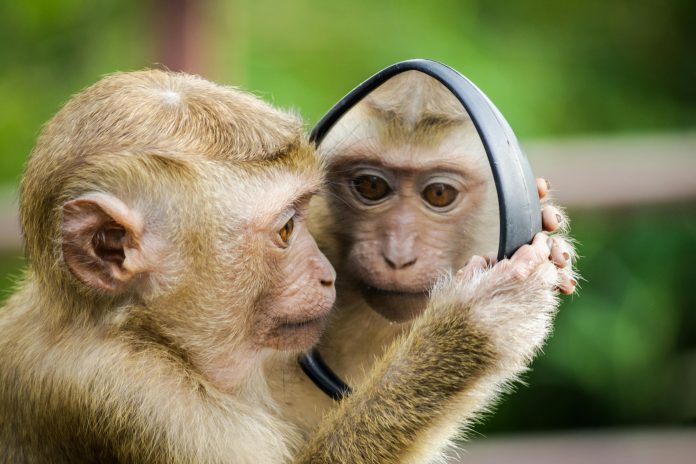What can monkeys actually teach us about corporate behavior, based upon real facts in regard to their own behavior?
You may have read the famous “monkey and the banana” story on the Internet in various blogs and articles. If not, it’s definitely worth a read. It’s about five monkeys, a ladder and a banana, and the key takeaway is about the human behavior of not challenging assumptions.
Interestingly, while many originally assumed it was based on fact, the story has been creatively tinkered with by successive writers. The background on the fact and fiction behind the story can be explored in an article in Psychology Today, “What Monkeys Can Teach Us About Human Behavior: From Facts to Fiction,” by Dario Maestripieri, a professor of comparative human development, evolutionary biology and neurobiology at the University of Chicago.
So what can monkeys actually teach us about corporate behavior, based upon real facts in regard to their own behavior?
Here are a few observations specific to the field of managing corporate innovation:
Evolve or die. Yes, monkeys have been doing this for a while now. Today, there are approximately 260 known living species. You may have heard the mantra “evolve or die” recently as it relates to digital business and digital transformation. Interestingly, this is not entirely new. The refrain “evolve or die” has been around since the e-business era in the late ’90s and even earlier. What’s new and different in today’s version is the pace of change that we’re dealing with in terms of the rate of innovation and the rate at which new business models are trumping older ones. Much like Ray Kurzweil’s visionary predictions of exponential growth in technology innovation, the pace of business innovation is following a similar trajectory — perhaps not exponential, but certainly accelerating.
An organization adopting new processes for corporate innovation can only assimilate a certain amount of change at a time. So rather than trying to implement a new, cutting-edge program as a big bang, it’s important to introduce various initiatives in a phased approach giving the organization time to digest the changes. For example, you may wish to start with internal processes such as innovation communities, methodologies, repositories, dashboards and metrics before extending collaborative innovation to customers and partners (or vice versa).
Be sociable. One of the social group patterns of monkeys is the “fission-fusion” society exhibited by chimpanzees. According to Dr. Dennis O’Neil in a tutorial on primate behavior, “a fission-fusion society is one in which the social group size and composition change throughout the year with different activities and situations.” Innovation communities need to be highly adaptive as well. It’s important to know your target communities and innovation roles. While you may have some idea forums that are open to all employees, such as general suggestions, it’s important to know your target communities, the types of ideas you want to solicit, and the specific business outcomes you want to derive from each.
By thinking about your “open innovation” strategy, you can develop a plan for how you’ll involve customers and business partners in addition to employees. You may also want to explore the concept of innovation scouts and brokers to see if that model may work in your organization. Basically, scouts and brokers are formally assigned resources who search for opportunities and then direct them to the appropriate parts of the organization. To get everyone on the same page across your organization, since “innovation” typically means different things to different people, it’s important to come up with precise terminology for innovation as well.
Follow a natural rhythm. Just as primates and monkeys follow natural daily and seasonal rhythms, it’s important for innovation processes to be aligned with and support both the tactical and strategic needs of the business. This means that you’ll likely need a combination of both event-based ideation and ongoing, enterprisewide ideation processes as part of your overall innovation strategy.
Event-based ideation: This ranges from large-scale, innovation events such as single- or multi-day, corporatewide “innovation jams” to innovation contests and partnerships with innovation labs, to laser-focused Innovation workshops with a select group of subject matter experts.
Ongoing ideation: This ranges from a corporatewide suggestion boxes and innovation databases of various levels of sophistication to more focused ideation processes typically aligned with corporate strategic communities, or corporate strategic planning cycles.
By implementing a multi-modal ideation approach, with both event-based and ongoing ideation vehicles, your organization will be well poised to maximize the innovation potential across your diverse ecosystem of employees, customers, suppliers and partners in a systematic manner and equally able to mobilize ideation sessions as, where and when opportunities arise.
Use tools. Chimpanzees use a variety of tools, and also design and make them for specific purposes. Termites are one of their favorite foods and, according to OneKind.org, chimpanzees are well known to “fish” for termites by stripping the leaves off a twig, inserting it into a termite mound, and then slowly withdrawing it with termites attached.
As an example, whereas 89% of the Fortune 500 went out of business between 1955 and 2014, in recent years, according to R “Ray” Wang of Constellation Research, 52% have been merged, acquired, gone bankrupt or fallen off the list solely since 2000. To keep up with this pace of change, you need to evolve your innovation program as well to adapt to the new requirements of digital transformation. My article “5 considerations for adapting innovation programs for digital transformation” outlines five important ways an existing corporate innovation program must change or be fine-tuned to most effectively support digital transformation both now and in the years to come.
Eat slowly. We may think monkeys sit around eating lots of bananas all day, but they actually they eat very few. In the wild, bananas make up a small part of their diet, and in captivity many zoos restrict the monkey’s intake of bananas to two per day, if any at all, due to their high sugar content. In terms of corporate innovation, if you’re rolling out a new global initiative for innovation management, it’s important to not try to do too much too soon. It’s important to give the organization a few bananas at a time as opposed to dropping the whole basket on them
One particular tool I’ve found very successful over the years has been group decision support software for running ideation sessions and innovation workshops. This is far more effective than using Post-it notes and allows you to capture a far greater number of ideas. It also provides a more democratic way to capture ideas from an entire group as opposed to solely those of the alpha males in the room, and provides an electronic record of the entire session which may also include voting results.
Beyond ideation tools, it’s useful to look across your entire corporate innovation program. To digitally transform your program, you can apply the same thinking that you apply to your externally focused innovation activities. For example, think about how the SMAC technologies can enable stronger social collaboration, mobile access, improved analytics and cost-effective and agile cloud delivery. Think about how innovation processes can be re-designed to be more customer-facing and produce results within faster cycle times.
As you can see, corporate innovation programs need to be living, breathing, socially-connected entities. They need to constantly adapt to their environment, evolve as the target business outcomes of innovation evolve, follow natural rhythms in terms of event-based and ongoing ideation, and be highly-attuned to your corporate culture and its appetite in terms of ability assimilate change.



























